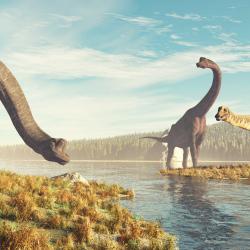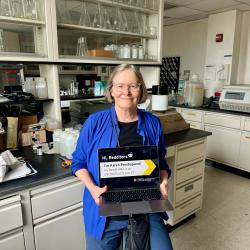University of Maryland Geophysicist Helps Identify Moonquake Dangers that Could Threaten Future Missions
A new study shows that seismic activity on the moon could pose risk to long-term lunar infrastructure.

A new paper revealed that ground acceleration from moonquakes, rather than meteor impacts, was responsible for shifting lunar landscapes at the moon’s Taurus-Littrow valley, where Apollo 17 astronauts landed in 1972. The study also pinpointed a possible cause for those surface changes and assessed damage risk using new models of the quakes—findings that may impact the safety of future lunar missions and the establishment of long-term bases on the moon.
The paper authored by Smithsonian Senior Scientist Emeritus Thomas R. Watters and University of Maryland Associate Professor of Geology Nicholas Schmerr was published in the journal Science Advances on July 30, 2025.
The scientists analyzed evidence from the Apollo 17 landing site, where NASA astronauts collected samples from boulder falls and landslides that were likely triggered by moonquakes. By studying the geological evidence left behind, the researchers were able to estimate the strength of these ancient moonquakes and identify their most probable source.
“We don’t have the sort of strong motion instruments that can measure seismic activity on the moon like we do on Earth, so we had to look for other ways to evaluate how much ground motion there may have been, like boulder falls and landslides that get mobilized by these seismic events,” Schmerr said.
The scientists found that moonquakes with magnitudes around 3.0—relatively weak by Earth standards but significant if close to the source—occurred repeatedly over the last 90 million years along the Lee-Lincoln fault, a geological fracture that crosses the valley floor. The pattern suggests that the fault, just one of thousands of similar faults on the moon, may still be active.
“The global distribution of young thrust faults like the Lee-Lincoln fault, their potential to be still active and the potential to form new thrust faults from ongoing contraction should be considered when planning the location and assessing stability of permanent outposts on the moon,” Watters said.
Watters and Schmerr also calculated lunar seismic risk, estimating a one in 20 million chance of a potentially damaging moonquake occurring on any given day near an active fault.
“It doesn’t sound like much, but everything in life is a calculated risk,” Schmerr noted. “The risk of something catastrophic happening isn’t zero, and while it’s small, it’s not something you can completely ignore while planning long-term infrastructure on the lunar surface.”
The researchers found that short-term missions, such as Apollo 17, were relatively low-risk, but longer-duration projects face incrementally higher exposure. Future missions with higher aspect ratio landers—such as the Starship Human Landing System—could be vulnerable to ground acceleration from nearby moonquakes that would threaten their stability. The findings are particularly relevant as NASA continues the Artemis program, which aims to establish a sustained human presence on the moon. Watters and Schmerr emphasized that future missions face additional considerations beyond Apollo-era risks.
“If astronauts are there for a day, they’d just have very bad luck if there was a damaging event,” Schmerr added. “But if you have a habitat or crewed mission up on the moon for a whole decade, that’s 3,650 days times 1 in 20 million, or the risk of a hazardous moonquake becoming about 1 in 5,500. It’s similar to going from the extremely low odds of winning a lottery to much higher odds of being dealt a four of a kind poker hand.”
Schmerr believes that his work with Watters represents a new frontier in lunar paleoseismology—the study of ancient earthquakes. Unlike on Earth, where scientists can dig trenches to study historic seismic activity, lunar researchers must rely on creative approaches using existing data and samples. Schmerr expects this field to rapidly advance with new technology, high resolution orbital imaging, and future Artemis missions that will deploy seismometers with 50-plus years of technological improvements over the Apollo-era instruments.
“We want to make sure that our exploration of the moon is done safely and that investments are made in a way that’s carefully thought out,” Schmerr said. “The conclusion we came to is: don’t build right on top of a scarp, or recently active fault. The farther away from a scarp, the lesser the hazard.”
###
This article was adapted from text provided by the Earth and Planetary Studies of the National Air and Space Museum, Smithsonian Institution.
The paper, “Paleoseismic Activity in the Moon’s Taurus-Littrow Valley Inferred from Boulder Falls and Landslides,” was published in Science Advances on July 30, 2025.
This research was funded by NASA’s Lunar Reconnaissance Orbiter mission, launched on 18 June 2009. LRO is managed by the NASA Goddard Space Flight Center for the Science Mission Directorate. This article does not necessarily reflect the views of this organization.







